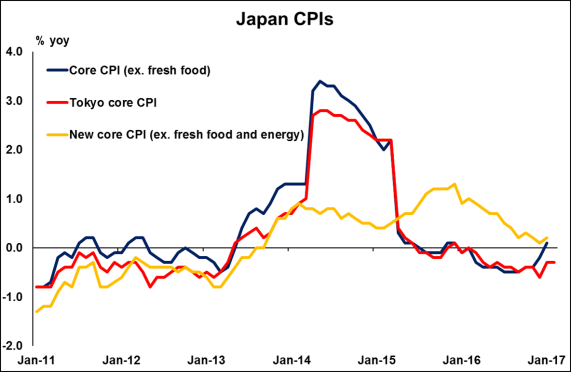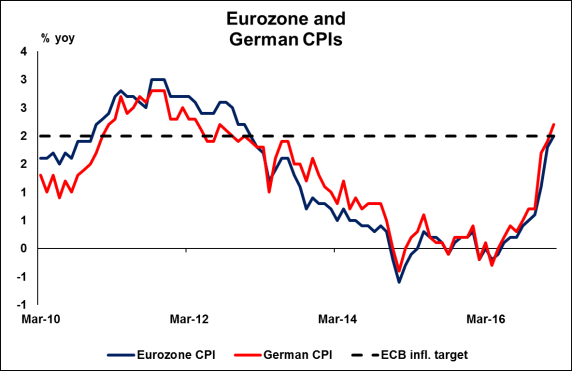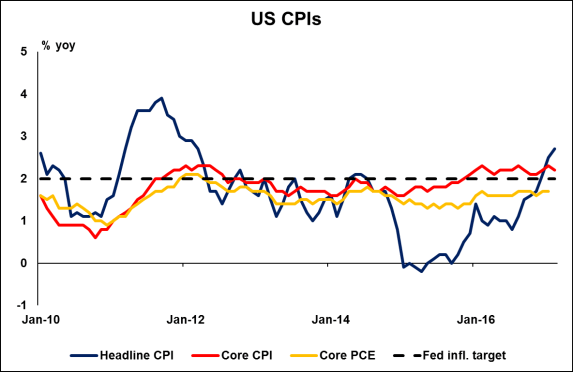Next week’s market movers
- In the UK, the Brexit journey will officially begin. PM May is expected to trigger Article 50 of the Lisbon Treaty, which will set the stage for two years of negotiations.
- In Euro area, preliminary inflation data for March will be closely followed amid mounting speculation regarding whether and when the ECB could begin to reduce its stimulus dose.
- From the US, we get the core PCE price index for February, the Fed’s favorite inflation measure. It could have a notable impact on market expectations regarding the timing of the next hike.
- We also get key economic data from Germany, the US, the UK, and Japan.
On Monday, we get Germany’s Ifo survey for March. The forecast is for the expectations index to have risen somewhat, while the current conditions figure is expected to have ticked down. We see the risks surrounding the current conditions forecast as skewed to the upside, perhaps for an increase instead of a marginal fall. We base our view on the ZEW and PMI surveys for the month, both of which showed increased optimism in the German economy. In fact, the PMIs indicated that the German economy is growing at its strongest pace for nearly six years, something that could also be reflected in the Ifo survey.

On Tuesday, the economic calendar is light, with no major events or indicators due to be released.
On Wednesday, the main event will be in the UK, where PM May is expected to trigger Article 50 of the Lisbon Treaty and commence the formal process for leaving the EU. We do not expect the actual triggering to be a particularly big market mover for sterling, as the move and timing have been signaled repeatedly over the past months and weeks. However, this is not an event to overlook as it will mark the beginning of two years of negotiations between the two sides. The most crucial issue, at least for financial markets, will be what kind of trade deal will be agreed, if one is agreed at all. Therefore, the pound’s forthcoming direction may be determined to a large extent by news headlines regarding how the negotiations are developing, particularly on the subject of trade. Signs that the UK is likely to end up with no free trade agreement, referred to as a "hard Brexit", could lead to further downside in the pound. However, given that much of the "hard Brexit" rhetoric may already be priced into the battered pound following months of tough comments from PM May, we believe that the political risks surrounding GBP are likely asymmetrical. Any positive developments during the negotiation process could generate a bigger upside reaction than the corresponding downside in case of the anticipated "hard Brexit" outcome.
On Thursday, we get Germany’s preliminary CPI figures for March, just one day ahead of Eurozone’s. The forecast is for the nation’s CPI to have slowed to +1.9% yoy from +2.2% yoy previously, something that would be exactly in line with the ECB’s target of "below, but close to, 2%". What’s more, we think that any potential slowdown in the CPI will likely be owed to temporary factors, such as past movements in the prices of food and energy. We base that assumption on the fact that the nation’s composite PMI survey for the month indicated that inflationary pressures remained extremely sharp, with firms raising their prices at the strongest rate since 2011. As a result, we doubt that any modest slowdown in headline inflation will be particularly worrisome for the ECB.
From the US, we get the final estimate of Q4. The forecast is for the figure to be revised up from the 2nd estimate, albeit marginally. Nonetheless, considering that the 1st quarter is almost over, we will treat these data as outdated. After all, it has only been a few days since the Fed’s latest decision to hike interest rates. We think that market participants will now look forward to the release of the 1st estimate of GDP for Q1, due out on the 28th of April, in order to have an up-to-date indication of how the US economy is performing and thereby, adjust their expectations with regards to the timing of the next increase in borrowing costs.

On Friday, during the Asian morning, we get CPI data for February from Japan. In the absence of any forecast, we see the case for the core rate to have remained unchanged, and for the headline rate to have declined. We base our view on the nation’s forward-looking Tokyo CPIs for February, where the core rate held steady, while the headline rate dropped notably. Even though a pullback in the headline rate may be discouraging news for BoJ policymakers, as long as the core rate does not fall, we do not expect this to spark speculation regarding further BoJ easing. The Bank could look through the decline in the headline rate as being transitory. With what we know today, we continue to expect the Bank to keep its ultra-loose QQE with yield-curve control framework unchanged in the foreseeable future. Although two BoJ policymakers have consistently called for reducing stimulus somewhat, most of the Board appears to have no intention of doing so, at least not until there has been significant progress in the profile for inflation, something not apparent yet.
From China, we get the official manufacturing and non-manufacturing PMIs for March, and then on Saturday, we get the nation’s Caixin manufacturing index for the month.
From Eurozone, we get preliminary CPI data for March. The forecast is for the headline CPI rate to have ticked down to +1.8% yoy from +2.0%, while the core rate is expected to have remained unchanged for the fourth consecutive month. The focus will probably be on the core CPI rate, following repeated signals from ECB policymakers that the Bank is "looking through" movements in the headline rate, which are mostly a result of temporary energy-related effects. Thus, investors are likely to pay a lot of attention to the core figure for any potential surprises, amid mounting speculation regarding whether and when the ECB is likely to begin to reduce its monetary stimulus dose. Eurozone’s PMI surveys for March were particularly upbeat on the subject of inflation, indicating that average prices charged for goods and services rose at the steepest rate since 2011. If incoming data continue to show mounting inflationary pressures, combined with robust economic growth, we expect the ECB to sound gradually more hawkish at its upcoming meetings, thereby preparing market participants for an eventual tightening, perhaps as early as next year. However, something like that is conditional upon the core CPI rate establishing an uptrend in coming months.

On Friday, we get the preliminary manufacturing and services PMIs for March from several European nations and the Eurozone as a whole. Most of these indices are expected to have ticked down, but to still remain at elevated levels. Considering that all of these surveys are expected to show that Eurozone’s economy continues to perform well, we believe that they are likely to be another set of pleasant news for ECB policymakers, who at their latest meeting shifted to a more optimistic tone. Although President Draghi reiterated that there is no convincing upward trend in the core CPI yet and as such the Bank will keep its stimulus program unchanged, he made it clear that there is diminished willingness among the Governing Council for any more extraordinary easing measures. If incoming data continue to show that economic growth and inflationary pressures are gradually picking up, then we would expect the ECB to drop more dovish aspects of its forward guidance in coming meetings. We think that the Bank’s next step is to remove the word "lower" from the reference regarding rates remaining at current, or lower levels in the foreseeable future.

In the UK, the final estimate of Q4 GDP is due out. Given that these data will be released on the final day of Q1, we see them as being outdated as well. However, we think that there is a particular component of the report that could attract market attention: business investment. The 2nd estimate was very interesting, because even though overall economic growth was revised upwards, business investment was revised significantly lower, with the updated numbers actually showing contracting investment. This generated concerns that the first real impact of Brexit-related uncertainties has already shown up, as firms appeared hesitant to invest ahead of the impending negotiations. As a result, we expect investors to look to the release of the 1st estimate of Q1 GDP, due out on the 28th of April, in order to determine whether this was a one-off, or if Brexit jitters have already began to weigh on economic growth.

From the US, we get personal income and spending data for February. Expectations are for both income and spending to have risen at the same pace as the previous month. We see the risks surrounding the spending forecast as skewed to the downside, perhaps for a slight slowdown, considering that retail sales slowed notably during the month.

What’s more, we also get the core PCE price index for February, though no forecast is available yet. Nevertheless, considering that this is the Fed’s favorite inflation measure, and that this rate has been range-bound since early 2016, it is likely to attract a lot of attention as investors try to determine the timing of the next rate hike. Our own view is that the core PCE rate may have remained unchanged, with risks skewed to the downside. The Price sub-indices of the nation’s ISM manufacturing and non-manufacturing PMI surveys for February ticked down, indicating that although prices continued to rise at a sharp pace, they rose somewhat slower than previously. What’s more, the core CPI rate for the same month ticked down, indicating that the latest pick-up in headline inflation is probably due to temporary factors, such as February’s yoy slowdown in the oil uptrend.












